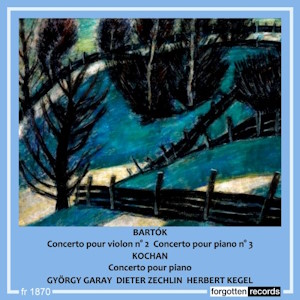
Béla Bartók (1881-1945)
Violin Concerto No. 2, Sz 112 (1938)
Piano Concerto No. 3, Sz 119 (1945)
Günter Kochan (1930-2009)
Piano Concerto, Op. 15 (1957-8)
György Garay (violin)
Dieter Zechlin (piano)
Leipzig Radio Symphony Orchestra/Herbert Kegel
rec. 1961, Kongresshalle, Leipzig
Forgotten Records FR1870 [79]
Here are three viscerally exciting commercial recordings set down in 1961. All three have been sourced from the Eterna and Deutsche Grammophon catalogues and digitally remastered from LP.
The soloist in Bartók’s Second Violin Concerto is the Hungarian born György Garay (1909-1988), who was a pupil of Jenő Hubay. A year before this recording was made he became concertmaster of the Radio Symphony in Leipzig. Warmth and intensity inform this rhythmically charged performance, with Garay responding instinctively to the Concerto’s fickle changing moods. His muscular, burnished tone and colour range are the perfect recipe for a score such as this. Kegel spurs him on all the way offering sensitive dynamic support.
Bartók shuns the more brutalistic style of his two previous piano concertos in the more conciliatory and accessible third, written for his wife Ditta and not completely orchestrated at his death. The seventeen bar completion of the finale is by Tibor Serly. The central slow movement is particularly well done. Gentle melancholy and radiant beauty is expressed by the orchestra’s sweet strings. In the outer movements, Dieter Zechlin’s technical mastery and Herbert Kegel’s rhythmical grip on proceedings raise the stakes and heighten the excitement.
The German composer Günter Kochan is a name completely new to me. His teachers included Boris Blacher and Hans Eisler. He spent many years teaching at the Hochschule für Musik Hanns Eisler, Berlin. His compositions include symphonies, orchestral works, chamber and choral music, film music and mass songs. Two works of his have received particular attention, his cantata Die Asche von Birkenau (1965) and his Music for Orchestra No. 2 (1987). Although his early work had a Brahmsian cast, he later forged his own personal style influenced by Paul Hindemith and Béla Bartók.
Kochan’s three-movement Piano Concerto was written in the late 1950s. It begins cautiously with a short clarinet and drum introduction, tentatively dipping its toe into the water so to speak. Then the Allegro begins, spirited in character and neoclassical in style. The drum interjects frequently. Moments of glowing lyricism alternate with more animated sections. The slow movement has a dreamy and pensive interior, where there’s an ongoing sense of wistful longing. In the spiky and angular finale the influence of Bartók is most evident. Kochan’s colourful orchestration throughout the work is impressive by any standards, and pianist Dieter Zechlin provides a dazzling display of virtuosity.
The Leipzig Radio Symphony Orchestra under the direction of Herbert Kegel are well-profiled and sound remarkably fine. There are no booklet notes. The release is worth acquiring for the Kochan alone.
Stephen Greenbank
| Availability |  |

















